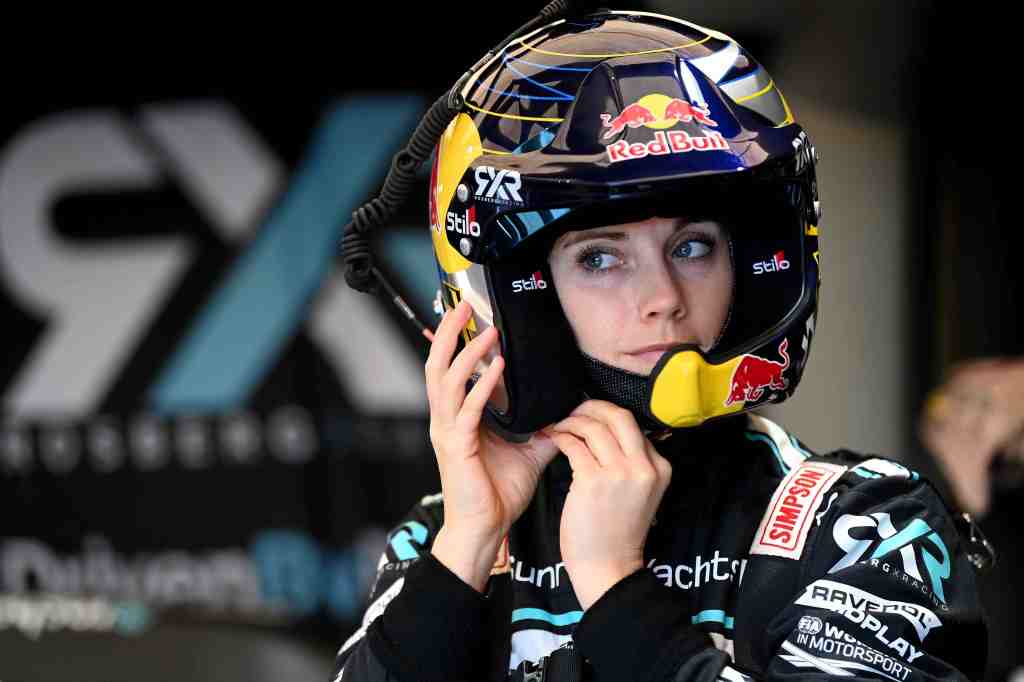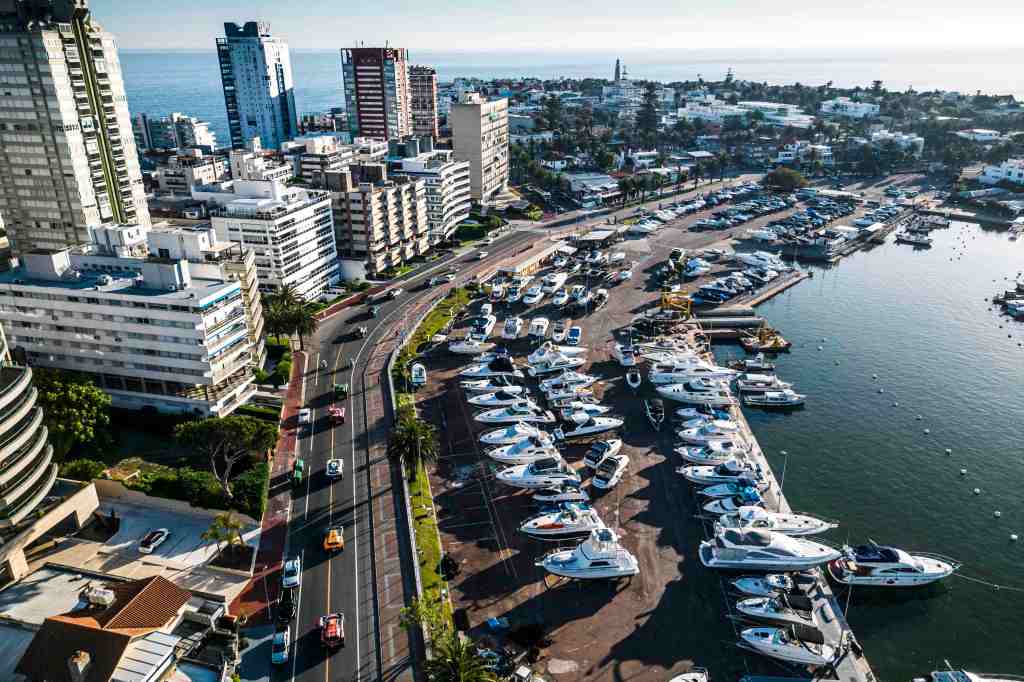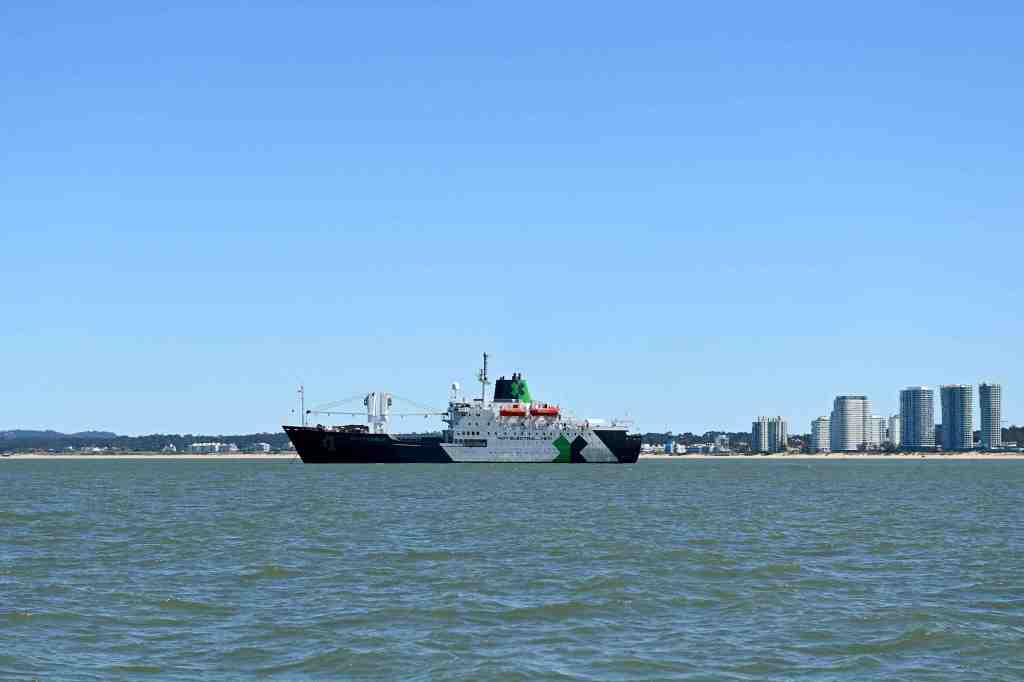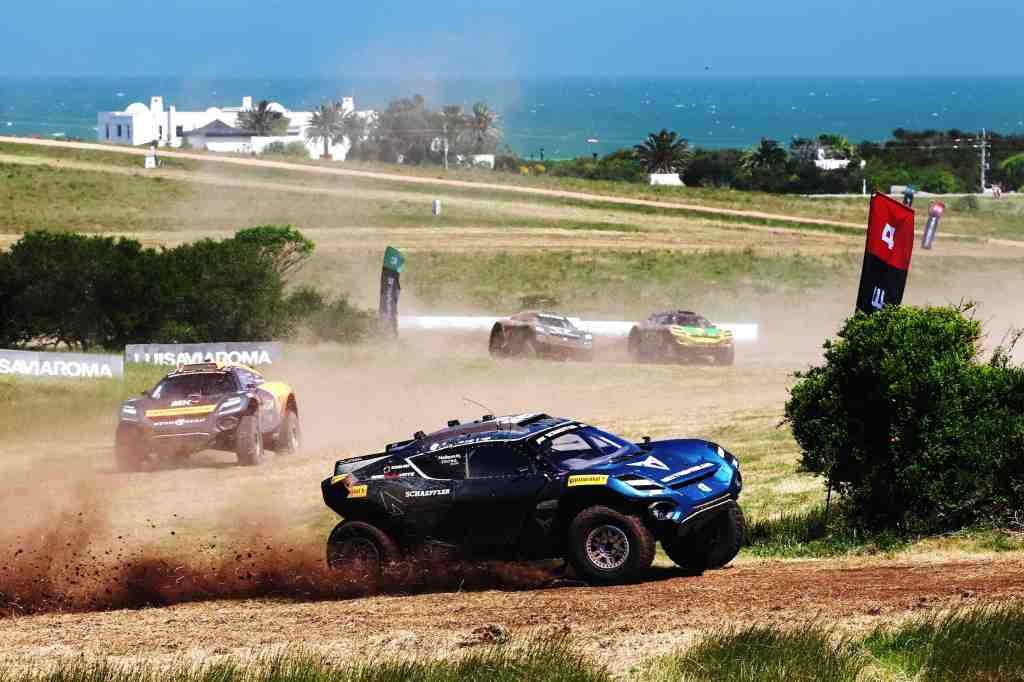Prior to kick-off, Fifa declared the World Cup in Qatar to be ‘a fully carbon-neutral event’, triggering enough spluttering, snorting and involuntary cackles to feed an entire wind farm. Seven giant brand-new stadiums, open-air air-conditioning in the desert, goodness knows how many long-haul flights in and out, and an armada of cruise ships to store the Wags. Righto, Mr Infantino. The Fifa president is the poster boy of talking tripe – the Comical Ali of sports-washing. Football is losing the climate fight like Costa Rica lost against Spain (7-0). Instead, the world’s most eco-friendly sport is motor racing.
I’m serious. Let me introduce you to Extreme E. Extreme E, or XE for short, is like Mad Max meets The Blue Planet. It’s an off-road championship for custom-made electric vehicles (EVs), racing in some of the world’s most remote and damaged environments, where the drivers take time out to plant carbon-capturing mangroves and swim with sea lions. Imagine Formula 1 with Sir David Attenborough in the commentary box and you get the idea.
This dramatic wheel-to-wheel competition, including jaw-dropping jumps and some of the biggest names in rallying (Carlos Sainz and Sébastien Loeb, who have 11 World Rally Championships between them, to name two), pulls in audiences of more than 18 million. Beyond entertainment, the series is designed to draw attention to our changing climate, instigate ways to combat it and show what EVs can do.

As well as the eco-angle, there’s diversity in action here too: half the drivers are women. Each team must field both a male and female pilot – the first time this has been mandated in motorsport. The women competing include 25-year-old Catie Munnings from Kent. ‘Normally we girls are all spread across the world in various championships, so it’s really good for so many of us to come together and encourage each other,’ she says. The competition between the sexes is perhaps the most enthralling element. ‘What we’ve seen from the female drivers has been extraordinary,’ says Extreme E’s founder and CEO Alejandro Agag. ‘We’ve built a platform where they can shine. And they deserve it because they’ve shown incredible talent and courage.’
Agag, 52, is a well-connected and well-resourced Spanish businessman. At 28 he was elected as an MEP. In 2002, he married the daughter of Prime Minister José Maria Aznar. King Juan Carlos, Tony Blair and Silvio Berlusconi attended the wedding. At this point, he quit politics, moved to London and became an entrepreneur, forming investment firm Addax Capital LLP. He bought a racing team and a share of Queens Park Rangers, and then in 2014 started Formula E – an all-electric single-seater championship, mostly competing on inner-city street tracks and drawing manufacturers such as Audi, Porsche, Jaguar and Nissan to develop EV tech and promote their brands as green. With his stellar political, hi-tech and commercial network, last year he switched his attention to a new and more rugged concept: Extreme E.
Agag is the modern Bernie Ecclestone meets showman Simon Cowell. He’s Richard Branson in his playboy prime, with a dash of Al Gore. The truth may be inconvenient, but that doesn’t mean we can’t watch racing cars go airborne.

Each X-Prix brings attention and philanthropy (via the sport’s investors and sponsors) to a specific ecological plight. The inaugural race in Saudi Arabia in April last year, for example, put the spotlight on desertification and the dwindling number of Red Sea turtles, while Senegal concentrated on plastic pollution and the sport is funding the planting of one million carbon-capturing mangroves there. The season one finale in Dorset – which saw the cars do battle around a particularly muddy Bovington Camp – produced a legacy programme to boost the local beaver population.
Dorset was a last-minute addition to the calendar. The Amazon and Ushuaia were called off due to South America’s Covid restrictions. Last year, I attended all five rounds, including Greenland, where I slept freezing in a tent on a glacier. Outside Dakar, I stayed in a tiny village on a dust road with more goats than people, saw a voodoo dance straight out of Live and Let Die and shared my sparsely furnished room with a rat the size of a well-nourished kitten.
It was, I felt, a proper adventure, so I was concerned season two mightn’t live up to these previous extremes. I was invited to attend the championship finale last week, the Energy X-Prix in Punte del Este, a place described as the St Tropez of Uruguay. Visually it’s more akin to Miami Beach, with high-rise condos, vivid sunsets and ritzy nightclubs – and the polar opposite of Kangerlussuaq, where I tucked into whale inside a shipping container that doubled as the only restaurant for 100 miles.

Punte del Este is not short on wealth, and this time I got to stay in a very very five-star hotel, the Fasano Las Piedras. My room was a chic, brutalist bungalow set beside an Arnold Palmer-designed golf course. This was wonderful, but I enjoyed the remoteness and frisson of danger at previous locations. I was therefore thrilled and reassured one evening – after the shock wore off – to find an enormous tarantula on my doormat hoping to come inside for a nightcap. Extreme E is still extreme, I thought. And no you can’t, scuttle off.
Whereas all XE’s prior destinations have been chosen for their tortured landscapes, including Sardinia which has been victim to wildfires, Uruguay was chosen as an example of when countries get it right. More than 98 per cent of Uruguay’s electricity comes from renewable sources, primarily wind and hydro. And I’ve never seen so much birdlife. There’s a big hole in the ozone layer, though, as a learnt to my detriment when turning down sun cream.
Sweden’s Kevin Hansen, 24, who races for British team Veloce, is passionate about the series’ wider aims. ‘One of the best aspects of this series is we really get to experience the locations. That doesn’t happen with World Rallycross, where we go to Wasp-y countries and just race. Here, we see the reality, we’re not hiding in our bubbles.’ The drivers can be found making content for broadcast and their own channels doing activities such as beach clean-ups and visiting schoolchildren before donning their helmets and doing the day job.

It’s easy to be cynical about motorsport beating the green drum; some of the world’s most privileged people jetting around to play with their dirt-churning toys. The series’ carbon footprint is, inevitably, greater than if everyone stayed at home but, as Agag likes to say: ‘You can’t make an omelette without breaking eggs.’
Whereas Formula 1 deems it necessary to employ more than 3,000 workers at every grand prix, XE makes do with about 350, including the people responsible for the outside broadcast. The ten teams are restricted to just six on-site technicians each, working out of khaki-coloured tents like the set of M*A*S*H. And unlike F1, which either trucks or flies its cars and kit around the world, XE traverses its calendar by sea.
The 105-metre St Helena is a 33-year-old former Royal Mail Ship which has been expensively refitted to transport all the championship’s cars and logistical equipment in 60+ shipping containers. With 62 cabins, it also hosts drivers and Agag’s entourage during race week. The St Helena’s engines are not electric, but they have been converted to run on low-sulphur diesel. It keeps the championship’s carbon footprint much lower than if the cars were flown to each round. Nevertheless, the ship – which sails from one race to the next – is by far the championship’s biggest carbon contributor. Her two 54-litre engines take 10,000 litres of fuel per day at sea, and 2,500 every day she’s in port just to run the ship.

Each evening, the ship’s guests hear presentations from leading scientists. The ship even has its own laboratory. Scientists are invited to take a residency on board for each leg of the season, analysing things such as seawater and bird migration. Agag was inspired by Jacques Cousteau’s research vessel, the Calypso.
We’re also given talks by climate and sustainability advocates specific to Latin America in the Explorer Lounge, the race site’s hospitality tent which caters for 80 or so invited guests. On collecting my access-all-areas lanyard, I’m handed a goodie bag with an XE cap and a traditional gaucho knife with a 6in blade. A couple of days later, this would lead to somewhat fraught discussions at the airport check-in desk.
Normally there are no spectators at these events but in Punta, for the first time, 6,000 locals were given free tickets and a fan zone was set up from which to watch the race.

I met up with Richard Washington, professor of climate science at Oxford University. He sits on XE’s scientific committee. ‘I’m a motor racing fan, which makes me an unlikely climate scientist,’ says the shyly-spoken South African. ‘Demonstrating what clean energy can do in a challenging environment like this, with snazzy cars running on clean energy, is the sort of nudge you need to make people see things differently.’
It was this that led 2016 F1 world champion Nico Rosberg, who’s become a high-profile eco-entrepreneur in his own right, to enter a team – Rosberg X Racing. RXR dominated the series last year, but in Punta a snapped steering arm in the heats put them on the back foot. In the final, the 2022 Extreme E championship went to the Sir Lewis Hamilton-owned X44.
For anyone who follows F1, you’ll know Lewis and Nico have some previous – friends since their teens who came to blows at Mercedes as they fought for supremacy. That rivalry added a fun edge to Sunday’s race result. ‘The bigger the rivalry, the better it will be to get Extreme E’s message across,’ agrees Rosberg. ‘The more visible this sport is, the more impact it will have. The power of sports is unbelievable.’

Christiana Figueres was, in her role as United Nations executive secretary on climate change, the main author of the 2015 Paris Agreement. I asked for her views on the need to turn petrolheads like me into electroheads. ‘The transport sector is responsible for roughly 30 per cent of the world’s carbon emissions,’ she explained. ‘We have to stop transporting ourselves in a polluting way. We need catalysts to spark changes in technology and behaviour. There’s no doubt that motorsport is exciting and has many fans. We need to bring all of those people on the same journey.’
A race to save the planet? Count me in, so long as the cars are fast and the crashes spectacular.







Comments